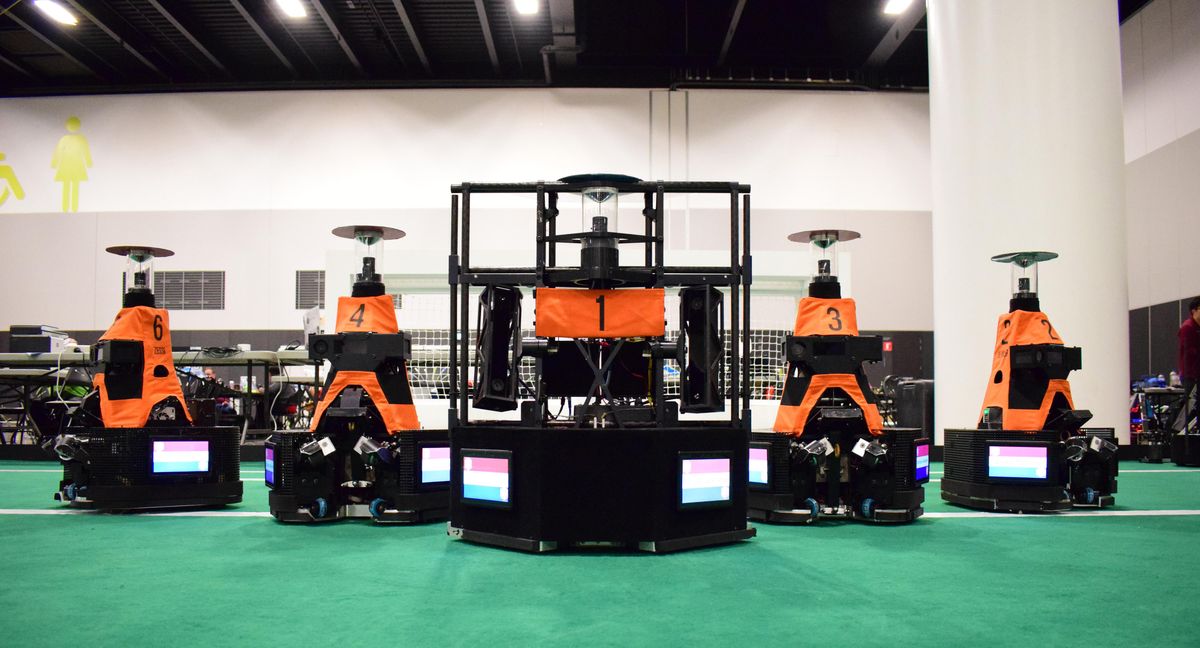Video Friday is your weekly selection of awesome robotics videos, collected by your friends at IEEE Spectrum robotics. We also post a weekly calendar of upcoming robotics events for the next few months. Please send us your events for inclusion.
RSS 2022: 21 June–1 July 2022, NEW YORK CITY
ERF 2022: 28–30 June 2022, ROTTERDAM, NETHERLANDS
RoboCup 2022: 11–17 July 2022, BANGKOK
IEEE CASE 2022: 20–24 August 2022, MEXICO CITY
CLAWAR 2022: 12–14 September 2022, AZORES, PORTUGAL
ANA Avatar XPRIZE Finals: 4–5 November 2022, LOS ANGELES
CoRL 2022: 14–18 December 2022, AUCKLAND, NEW ZEALAND
Enjoy today’s videos!
The European Robocup Finals 2022, featuring Tech United vs. VDL Robotsports.
[ Tech United ]
Within the European Union project we aim to autonomously monitor habitats. Regular monitoring of individual plant species allows for more sophisticated decision-making. The video is recorded in Perugia Italy.
[ RSL ]
ICRA 2023 is in London!
[ ICRA 2023 ]
What can we learn from nature? What skills from the animal world can be used for industrial applications? Festo has been dealing with these questions in the Bionic Learning Network for years. In association with universities, institutes and development companies, we are developing research platforms whose basic technical principles are based on nature. A recurring theme here is the unique movements and functions of the elephant’s trunk.
[ Festo ]
We are proud to announce the Relaunch of Misty, providing you with a more intuitive and easy-to-use robot platform! So what is new, we hear you ask? To begin with, we have updated Misty’s conversational skills, focusing on both improved NLU capabilities and added more languages. Python has been added as our primary focus programming language going forward, complemented by enhanced Blockly drag and drop functionality. We think you will really enjoy our brand new Misty Studio, which is both more user friendly and with improved features.
[ Misty ]
We developed a self-contained end-effector for layouting on construction sites with aerial robots! The end-effector achieves high accuracy through the use of multiple contact points, compliance, and actuation.
[ Paper ]
The compliance and conformability of soft robots provide inherent advantages when working around delicate objects or in unstructured environments. However, rapid locomotion in soft robotics is challenging due to the slow propagation of motion in compliant structures, particularly underwater. Taking inspiration from cephalopods, here we present an underwater robot with a compliant body that can achieve repeatable jet propulsion by changing its internal volume and cross-sectional area to take advantage of jet propulsion as well as the added mass effect.
[ UCSD ]
I like this idea of making incidental art with robots.
[ RPL UCL ]
If you want to be at the cutting-edge of your research field and publish impactful research papers, you need the most cutting-edge hardware. Our technology is unique (we own the relevant IP), unrivaled and a must-have tool for those in robotics research.
[ Shadow ]
Hardware platforms for socially interactive robotics can be limited by cost or lack of functionality. This article presents the overall system—design, hardware, and software—for Quori, a novel, affordable, socially interactive humanoid robot platform for facilitating non-contact human-robot interaction (HRI) research.
[ Paper ]
Wyss Associate Faculty members, Conor Walsh and Rob Wood discuss their visions for the future of bio-inspired soft robotics.
[ Wyss Institute ]
Towel folding: still not easy for robots.
[ Ishikawa Lab ]
We present hybrid adhesive end-effectors for bimanual handling of deformable objects. The end-effectors are designed with features meant to accommodate surface irregularities in macroscale form, mesoscale waviness, and microscale roughness, achieving good shear adhesion on surfaces with little gripping force. The new gripping system combines passive mechanical compliance with a hybrid electrostatic-adhesive pad so that humanoid robots can grasp a wide range of materials including paperboard and textured plastics.
[ Paper ]
MIT CSAIL grad students speak about what they think is the most important unsolved problem in computer science today.
[ MIT CSAIL ]
At the National Centre of Competence in Research (NCCR) Robotics, a new generation of robots that can work side by side with humans—fighting disabilities, facing emergencies and transforming education—is developed.
[ NCCR ]
The OS-150 Robotics Laboratory is Lawrence Livermore National Laboratory’s facility for testing autonomous drones, vehicles, and robots of the future. The Lab, informally known as the “drone pen,” allows operators to pilot drones safely and build trust with their robotic teammates.
[ LLNL ]
I am not entirely certain whether a Roomba is capable of detecting and navigating pixelated poop IRL, but I’d like to think so.
[ iRobot ]
How Wing designed its hybrid drone for last-mile delivery.
[ Wing ]
Over the past ten years, AI has experienced breakthrough after breakthrough in fields as diverse as computer vision, speech recognition, and protein folding prediction. Many of these advancements hinge on the deep learning work conducted by our guest, Geoff Hinton, who has fundamentally changed the focus and direction of the field. Geoff joins Pieter Abbeel in our two-part season finale for a wide-ranging discussion inspired by insights gleaned from Hinton’s journey from academia to Google Brain.
[ Robot Brains ]
Evan Ackerman is a senior editor at IEEE Spectrum. Since 2007, he has written over 6,000 articles on robotics and technology. He has a degree in Martian geology and is excellent at playing bagpipes.



